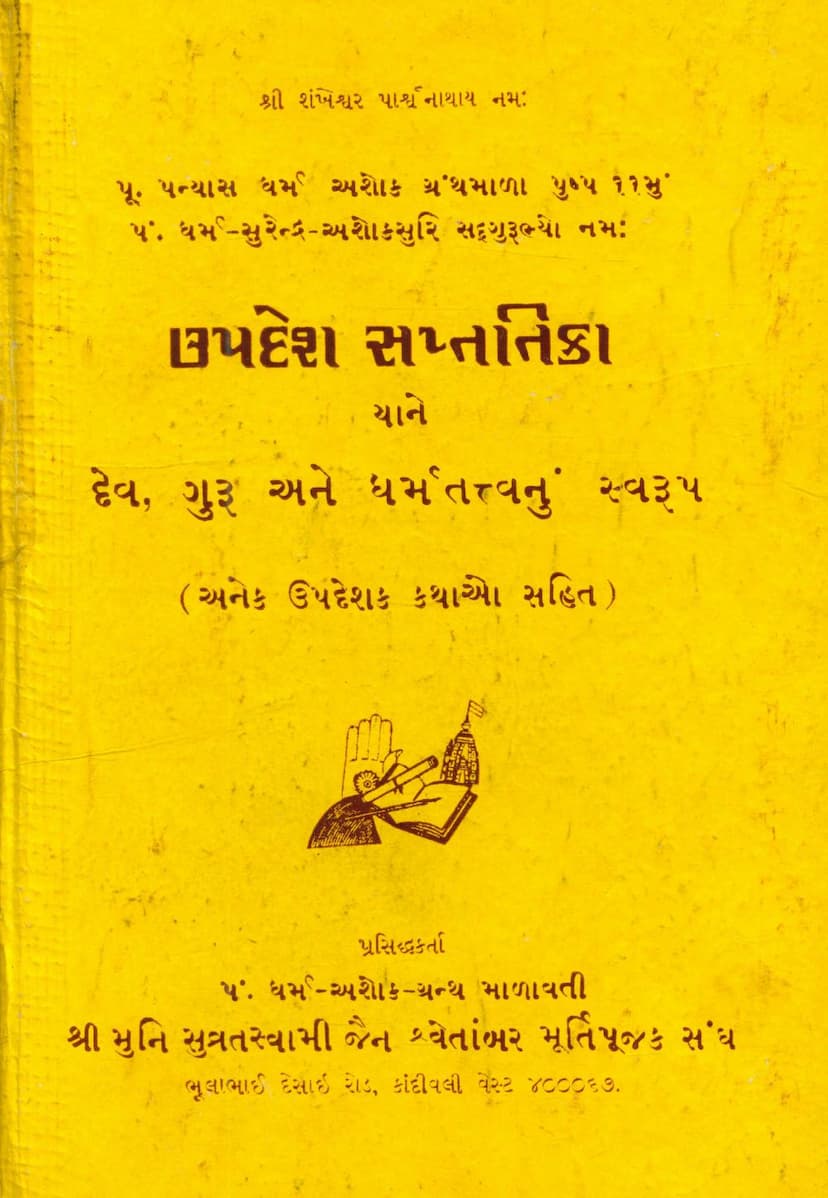Updesh Saptatika
Added to library: September 2, 2025

Summary
Here's a comprehensive summary of the Jain text "Updesh Saptatika," based on the provided pages:
Title: Updesh Saptatika (Collection of Seventy Teachings) Subtitle: Describing the Nature of Divinity, Guru, and Dharma (with Numerous Exemplary Stories) Author: Dharm Ashok Granthmala (published by Dharm Ashok Granthmala) Publisher: Shri Munisuvatswami Jain Shwetambar Murtipujak Sangh, Kandivali, Mumbai.
Core Theme: The book, "Updesh Saptatika," serves as a guide to understanding and practicing the fundamental principles of Jainism. It focuses on the essence of Dev (Divine beings), Guru (Spiritual teachers), and Dharma (Righteous path). The author, through a collection of teachings and illustrative stories, aims to illuminate these core elements to guide individuals towards spiritual progress and eventual liberation (moksha).
Structure and Content: The book is divided into five sections (Adhikars):
-
Nature of Divinity (Devatattva ka Swarup): This section comprises twenty-four teachings. It likely elaborates on the qualities and significance of the Arihants and other celestial beings in Jainism, emphasizing their role in guiding souls towards liberation.
-
Nature of the Pilgrimage Site (Tirth ka Swarup): This section contains seventeen teachings. It probably discusses the importance and sanctity of Jain pilgrimage sites, their historical significance, and the spiritual benefits derived from visiting them.
-
Nature of the Guru (Guru Tattva ka Swarup): This section includes five teachings. It focuses on the essential role of a Guru in the spiritual journey, explaining their qualities, the importance of reverence and devotion towards them, and how they illuminate the path to moksha.
-
Nature of Dharma (Dharma Tattva ka Swarup): This section consists of twelve teachings. It delves into the core principles of Jain Dharma, likely explaining concepts like non-violence (ahimsa), truthfulness (satya), non-stealing (asteya), celibacy (brahmacharya), and non-possession (aparigraha) – the five great vows. It also likely discusses the importance of right faith (samyak darshan), right knowledge (samyak gyan), and right conduct (samyak charitra).
-
Nature of Householder's Dharma (Grihasth Dharma ka Swarup): This section comprises seventeen teachings. It outlines the duties and responsibilities of lay followers, emphasizing how they can integrate spiritual practices into their daily lives while upholding ethical conduct and social responsibilities.
Key Message and Philosophy: The book emphasizes that progress on the path to moksha is contingent upon recognizing the true nature of Dev (the Arihants), understanding the guidance of the Guru, and diligently following the principles of Dharma. The text highlights that without this understanding and practice, one cannot truly advance spiritually. It stresses that the Arihants, through their teachings and the path they laid out, are the ultimate means to overcome worldly suffering and attain eternal bliss. The Guru, as the torchbearer of this knowledge, plays a crucial role in conveying the teachings of the Arihants to the disciples. The book's narrative style, enriched with numerous stories, aims to make these profound philosophical concepts accessible and relatable to a wider audience.
Theological and Ethical Framework: The "Updesh Saptatika" is firmly rooted in the tenets of Jainism, particularly the importance of the "Ratnatraya" (Three Jewels): Samyak Darshan (right faith), Samyak Gyan (right knowledge), and Samyak Charitra (right conduct). It also underscores the significance of devotion to the Arihants and the Guru, the adherence to Jain ethical principles, and the practice of virtues.
Authoritative and Inspirational Tone: The book is presented with an authoritative yet inspirational tone. It encourages readers to strive for spiritual upliftment by diligently studying and internalizing the teachings presented within its pages. The publication is a testament to the efforts of the Dharm Ashok Granthmala and the Munisuvatswami Jain Shwetambar Murtipujak Sangh in propagating Jain teachings.
Target Audience: The book appears to be intended for a broad audience within the Jain community, aiming to educate and inspire individuals from all walks of life – from those new to the faith to seasoned practitioners – about the core tenets of Jainism. The use of stories suggests an effort to make the teachings engaging and memorable.